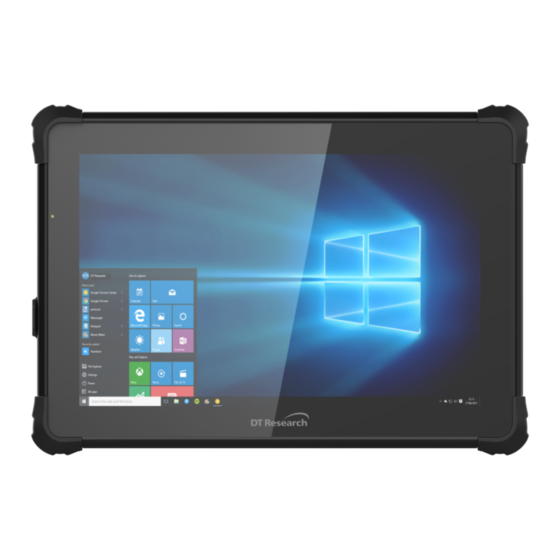Table of Contents
Advertisement
Quick Links
DT380CR
BASIC OPERATION GUIDE
ENGLISH
INTRODUCTION
Thank you for acquiring the DT380CR, part of DT Research's line of tablets. Featuring a slim yet
robust enclosure, the DT380CR with 8" TFT display is powered by the Intel® Atom™ quad-core
processor, offering optimal combinations of performance and power savings. The DT380CR is
available with Microsoft® Windows® operating system. The software operating system features
web browser, client/ server computing software, media player, accessories, and applications
support.
PACKAGE CONTENTS
• One DT380CR with Battery Pack and Handstrap
• AC-DC Power Adapter with Power Cord
• Basic Operation Guide
Major options, depending on configuration:
• Desktop Charging Cradle with DC-in Power Jack
• Additional Battery Pack
* If your DT380CR contains camera or barcode scanner, please refer to the Tablet Modules Basic Operation Guide for
detailed operation.
Advertisement
Table of Contents

Summary of Contents for DT Research DT380CR
- Page 1 • Basic Operation Guide Major options, depending on configuration: • Desktop Charging Cradle with DC-in Power Jack • Additional Battery Pack * If your DT380CR contains camera or barcode scanner, please refer to the Tablet Modules Basic Operation Guide for detailed operation.
- Page 2 DT380CR Input/ Output Ports Headphone Jack Back Camera (optional) USB Port Barcode Scanner (optional) DC Power Input Button Functions BUTTON ACTION Power button Programmable button without the scanner module As scanner trigger when equipped with the scanner module Battery latch...
- Page 3 A DT380CR typically integrates an 802.11ac wireless LAN (WLAN) adapter that may connect to other wireless devices or access points. If your DT380CR does not come with such a network adapter, please consult your device provider to establish the desired network connectivity.
- Page 4 Powering ON and OFF To activate the DT380CR, push and quickly release the Power Button. The display will come on in a few seconds. To put the DT380CR in Standby mode, push and quickly release the Power Button. To turn the DT380CR off for extended storage, power off safely using any software function that “shuts down computer”...
- Page 5 The DT380CR is often delivered with an embedded (user-inaccessible) 802.11ac WLAN adapter equipped with a hidden custom antenna. • Through the support of typical WLAN adapters, the DT380CR should be able to detect all 802.11 access points in the vicinity for you to select the access point of your choice for connection.
- Page 6 Bluetooth connectivity with the corresponding peripherals. USING THE MOBILE TABLET Peripherals Support Through its USB port, the DT380CR supports a wide range of USB-based peripherals. These peripherals are applicable for software installation, applications storage, data storage, and system software recovery and updates. Remote Management Depending on software configuration, the DT380CR can be centrally managed for asset monitoring and for software control.
- Page 7 Operation: 32°F to 122°F (-0°C to 50°C); Storage: -4°F to 140°F (-20°C to 60°C) Humidity 0% – 90% non-condensing DT Research, Inc. 2000 Concourse Drive, San Jose, CA 95131 http://www.dtresearch.com Copyright © 2019, DT Research, Inc. All Rights Reserved. ENGLISH BOG062419DT380CRENG...
- Page 8 FCC Regulatory Compliance This device complies with Part 15 of the FCC Rules. Operation is subject to the following two conditions: (1) This device may not cause harmful interference, and (2) this device must accept any interference received, including interference that may cause undesired operation. Warning: changes or modifications not expressly approved by the party responsible for compliance could void the user’s authority to operate the equipment. Note: This equipment has been tested and found to comply with the limits for a Class B digital device, pursuant to Part 15 of the FCC Rules. These limits are designed to provide reasonable protection against harmful interference in a residential installation. This equipment generates, uses and can radiate radio frequency energy and, if not installed and used in accordance with the instructions, may cause harmful interference to radio communications. However, there is no guarantee that interference will not occur in a particular installation. If this equipment does cause harmful interference to radio or television reception, which can be determined by turning the equipment off and on, the user is encouraged to try to correct the interference by one or more of the following measures: ‐‐ Reorient or relocate the receiving antenna. ‐‐ Increase the separation between the equipment and receiver. ‐‐ Connect the equipment into an outlet on a circuit different from that to which the receiver is connected. ‐‐ Consult the dealer or an experienced radio/TV technician for help. RF Exposure Compliance This equipment complies with FCC radiation exposure limits set forth for an uncontrolled environment. The device has been tested for use against the body with 0mm separation in Specific Absorption Rate (SAR) testing. User must follow the specific operating instructions for satisfying RF exposure compliance. This transmitter must not be co‐located or operating in conjunction with any other antenna or transmitter. FCC ID Label is in removable battery compartment, it could be easily found by removing the battery cover.
















Need help?
Do you have a question about the DT380CR and is the answer not in the manual?
Questions and answers